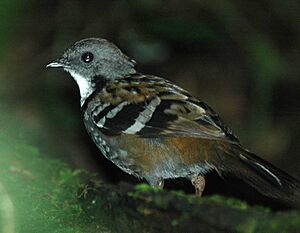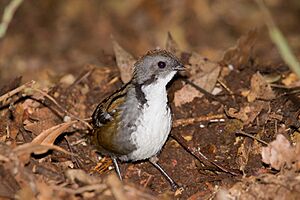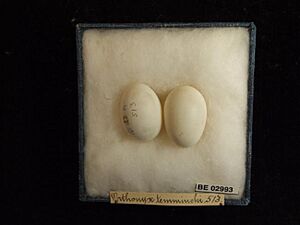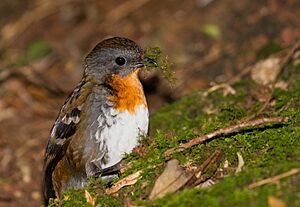Australian logrunner facts for kids
Quick facts for kids Australian logrunner |
|
|---|---|
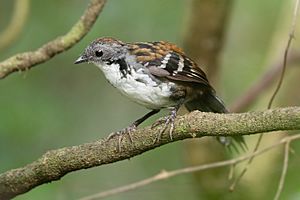 |
|
| Conservation status | |
| Scientific classification | |
| Genus: |
Orthonyx
|
| Species: |
temminckii
|
The Australian logrunner (Orthonyx temminckii) is a special type of bird. It lives only in eastern Australia. This bird has amazing ways to find its food. It searches on the ground in warm, wet forests.
Before 2002, people thought it was the same as the New Guinea logrunner. But scientists found they are very different. Their genes and calls are not alike. This bird is also known by other names. These include spine-tailed logrunner, spine-tail, logrunner, scrub quail, and chowcilla.
Contents
What Kind of Bird Is It?
The Australian logrunner belongs to a bird family called Orthonychidae. It's a type of Passerine bird, also known as a 'perching bird'. There are only three species in its group, called the Orthonyx genus. The other two are the chowcilla (Orthonyx spaldingii) from northern Queensland. The third is the New Guinean logrunner (Orthonyx novaeguineae) from Papua New Guinea.
How to Spot an Australian Logrunner
Logrunners are known for their unique tail feathers. The middle part, called the rachis, sticks out and is very stiff. The tail is less than 4 inches (10 cm) long. The stiff parts at the end of the feathers have almost no soft parts. This makes them look like spines. This is why some people call them spine-tails.
Other birds also have special tail feathers. For example, woodpeckers and swifts use their tails to help them climb or balance. But the logrunner's tail is very unique.
Colors and Size
The logrunner's head and back are a reddish-brown color. Its wings are mostly black. The tail is dark brown. The tips of its wing feathers are grey. Its eyebrow and ear areas are also grey. The throat, chest, and belly feathers are white.
Female logrunners have an orange-red throat. Male logrunners are usually bigger than females.
Where Do Logrunners Live?
The Australian logrunner lives in South Eastern Australia. You can find them from the Illawarra area in New South Wales. They also live up to the Bunya Mountains in Queensland. They love to live in rainforests. These forests have lots of leaves on the ground. They also have scattered logs, plants, ferns, and small trees.
Amazing Ways Logrunners Find Food
The most special thing about logrunners is how they find food. They lean on their spiny tail. Then they use their feet to scrape or throw leaves aside. Once the big leaves are gone, they use their tail to brace themselves. They scratch the dirt to look for food. This scratching leaves round holes in the ground. These holes are about 6 inches (150 mm) wide.
Logrunners can sweep their legs sideways when they search for food. This is very rare for birds. It's possible because of their special body shape. Their hip bones are short and wide. Their leg bones are strong. They have powerful muscles to help them with this unique way of finding food.
Logrunners are also known for being noisy birds. They sing and call loudly, especially in the mornings. These songs and calls might help them protect their area. They might also help them find a mate.
What Do Logrunners Eat?
Logrunners mainly eat insects. They also eat other small creatures without backbones. They find all their food by searching on the forest floor.
Logrunner Family Life
Logrunners live in pairs or small groups. They protect their home area strongly from other birds. They are believed to stay with the same partner for life.
The female logrunner lays two white, oval-shaped eggs. Each egg is about 1.14 × 0.94 inches (29 × 24 mm) in size. The eggs hatch after 20 to 25 days.
Logrunners usually breed between May and August. However, they can sometimes breed at other times of the year.
Building a Nest
The female builds a large, domed nest. It has a ramp leading up to it. The nest is made from sticks, ferns, leaves, and natural fibers. It is often covered with green moss. The inside of the nest is lined with softer materials. Nests are usually built against a stone or log. They can also be in a tree or in thick vines close to the ground.
Logrunners hide their nests very well. They put leaves and sticks from around the area on top of the nest. They also build a hood over the entrance using moss. This makes the nest hard to see.
Building the nest involves several steps:
- First, the bird lays a base of strong, dry sticks. This base can be up to 2 inches (50 mm) thick.
- Then, short, strong sticks are used to build the sides and back. These sticks curve over the top to form a roof.
- The roof and walls are covered with dry leaves and moss. This layer is about 1 inch (25 mm) thick.
- More dry leaves and twigs are placed on top of the moss roof for better hiding.
- The moss roof extends forward to form a hood over the entrance. This almost hides the opening.
- Finally, the inside of the nest is lined with soft, dry plants. These include bark, dry moss, and fern fibers.
Only the female builds the nest. She is also the only one who sits on the eggs. This takes 20 to 25 days. She also takes care of the young birds until they leave the nest. This happens when they are 16 to 19 days old. Both the male and female help feed the young after they leave the nest.
Images for kids
See also
 In Spanish: Colaespina de Temminck para niños
In Spanish: Colaespina de Temminck para niños



